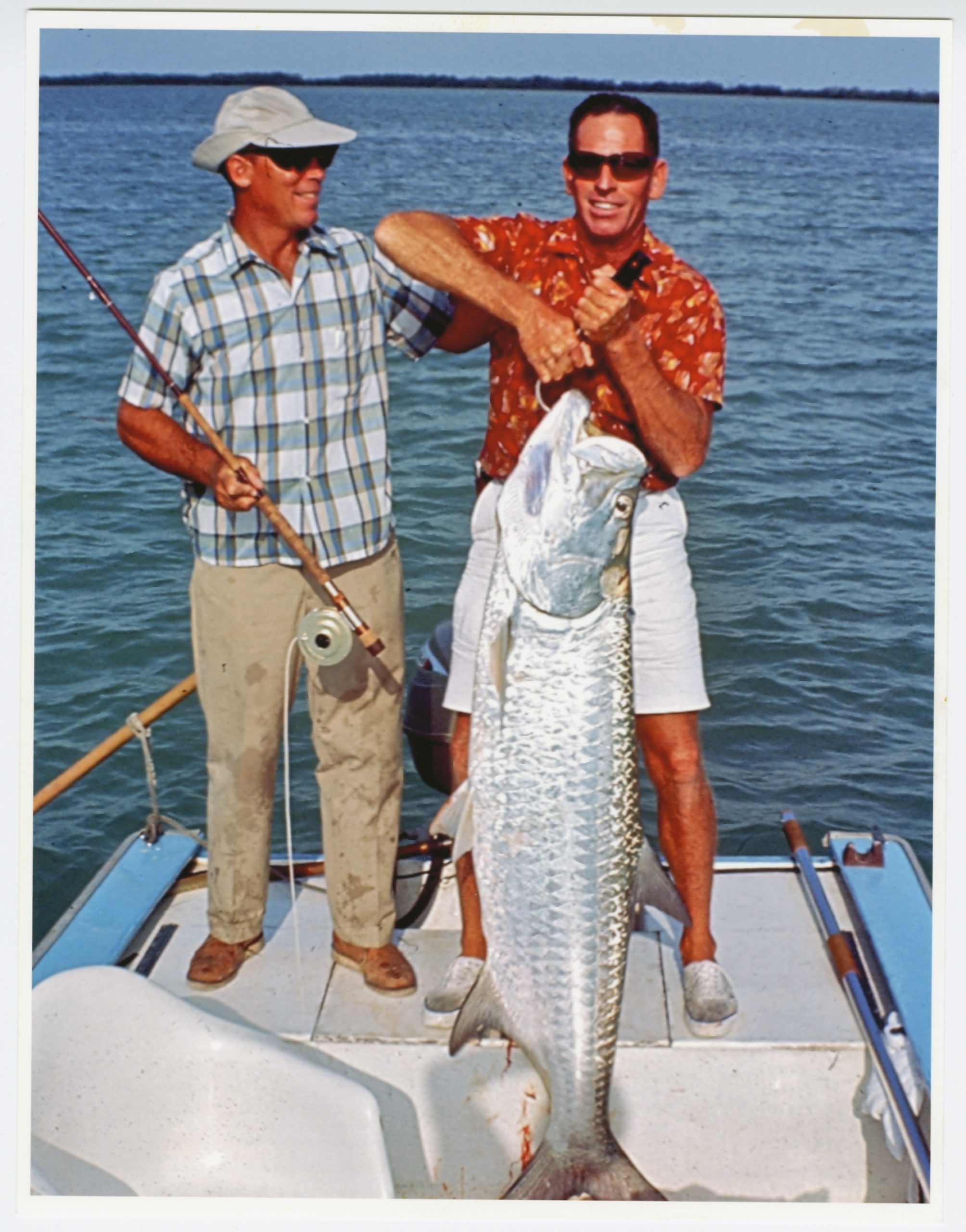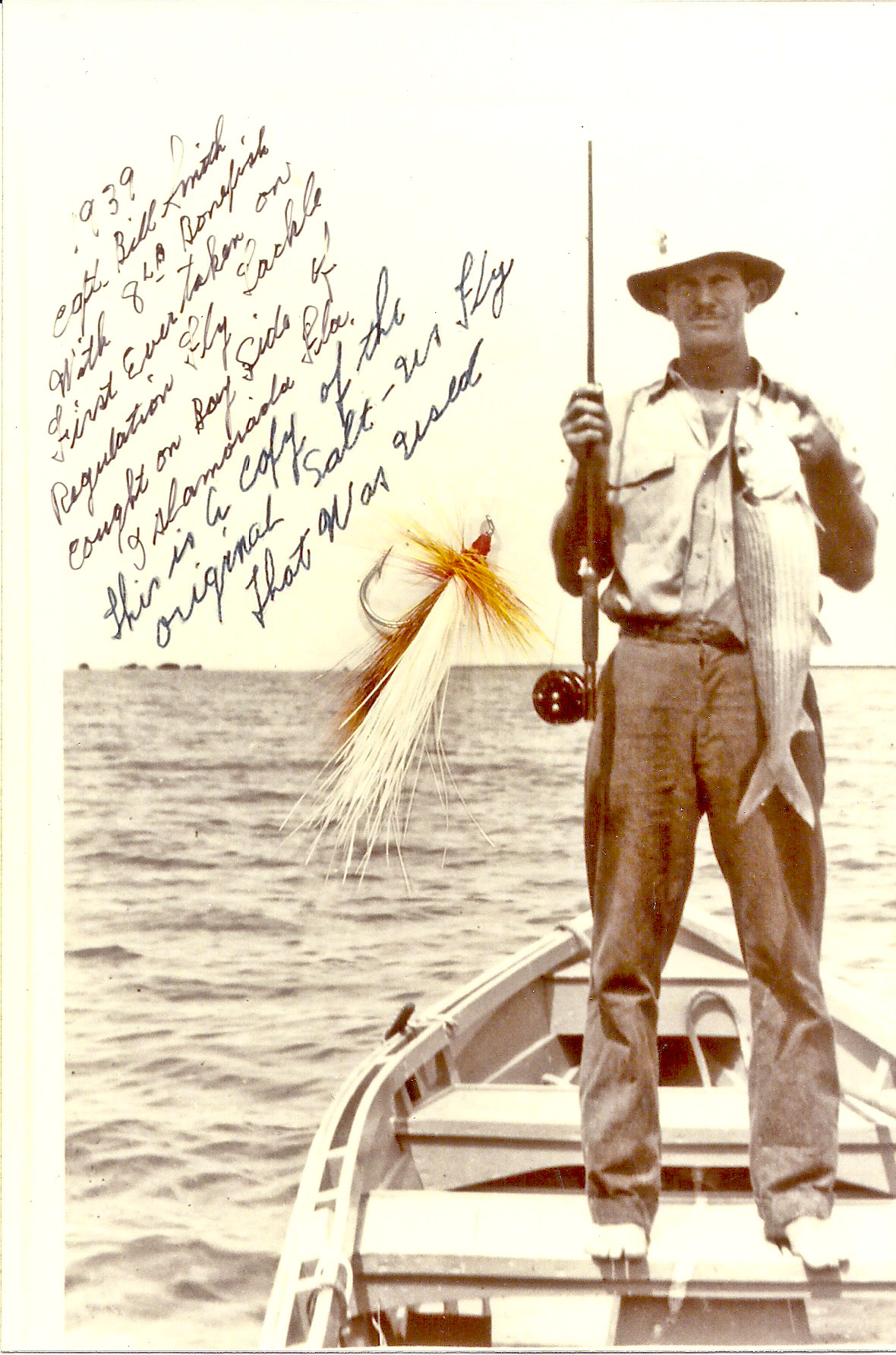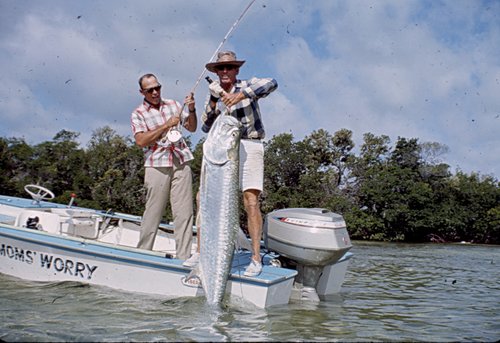By Captain Bill Curtis (1925-2016)
When I came to Miami in 1948 there was a huge tarpon population in Biscayne Bay. Every canal and creek even the ones you could jump across that ran into the bay had juvenile tarpon in them, some I caught on trout streamers small as four inches long. Most of that habitat no longer exists and the habitat that does is infected with insecticides and fertilizers. In 1950 I started collecting samples of baby tarpon for Richard Wade, a marine biologist with the University of Miami, who was the first biologist to wright [sic.] the biology of the tarpon and to determine growth rates. In the mid fifties we caught and tagged over fifty of these baby tarpon (18-20 inches) in one canal. Two months later Richard Wade found all of these tarpon dead. The victims of fertilizer or insecticides that poisoned all of these fish.
When I started guiding in 1955 I began to learn how tarpon spend the winter in Broward and Dade counties in inland waters. If these waters became too cold for them they would move out to the outer reefs and gulf stream where the water would be ten to fifteen degrees warmer. They would also become inactive and lie dormant in deep channels near the bottom, such as Government Cut which was 45 to 50 ft. deep. You would not see any tarpon rolling but be marking thousands on the bottom. When the water temp go close to 75 degrees they would come up and start rolling and feeding again.
The average weight of these tarpon we caught was about 70 lbs. with one over 100 lbs. not unusual. Most being 5 ft. to 6 ½ feet long. When the temperature reached 80 degrees or above the tarpon would average much smaller, 20 to 30 pounds during warmer months in Biscayne Bay after large tarpon had gone north.
Small tarpon can be found year round in southern Florida. Tarpon over 50 lbs. can be found along beaches from Bakers Haulover to Government Cut. If you find a large school of mullet tarpon will be busting into them, some coming completely out of the water.
I believe when tarpon became 5 ft. long or more they become migratory. I have been fishing in Government Cut in May with schools of fish rolling everywhere and all of a sudden they all would disappear. I would start running south and before I got to Key Biscayne I would find schools of tarpon rolling heading south. All of these schools of migratory fish head south and west all the way to Islamorada, starting in March or April if the water gets warm enough. Then tarpon start migrating north about the last of May. By the middle of June about all the schools are going north for the summer on the east coast of Florida. Before there were flats guides in Key West I would take charters there. In April and May I would find schools of migrating tarpon on the flats West of Key West heading east in large numbers towards Islamorada and Florida Bay. I would also find them northwest of Key West going east along the Mid Keys, Summerland, and Content Keys heading for Florida Bay.
I have fished for tarpon at this time of the year in the Dry Tortugas, Marquesas, Key West to Miami and Fort Lauderdale, Florida Bay, and west coast of Florida north to Homosassa and Crystal River. Tarpon fishing can be the best in all of these places at the same time- one migration on the east coast of Florida, one on the west coast. Therefore, I have come to the conclusion there are different populations of large migratory tarpon or so many places would not be good at the same that are far removed.

Bill Curtis and Stu Apte with another tarpon. Pat Ford photo.
For many years I had all the flats that large tarpon moved over all to myself from Miami to Key Largo. The bonefish guides on north Key Largo would not fish for tarpon. At times I guided clients staying in Islamorada in Florida Bay, from Lignumvitae Basin Key North to Man of War Key. Also west to Duck Key.
One of the largest schools of tarpon I ever saw was on the ocean side of Elliot Key (Biscayne Bay). It had several thousand fish in it, my angler hooked an average size fish at the front of the school, and while fighting this fish over 30 minutes on fly rod tarpon were streaming by us on both sides of the boat. Many times while fishing west of Key West I was never out of sight of schools of tarpon heading toward us all day long, one school after another, on the south side of Boca Grande or Women Key. I have seen the same thing happen when I first started fishing out of Homosassa, fish on the west side of the St. Martens Ils., Chasawitska Point, and west of Pine Island. These huge numbers of tarpon do not exist today. About the same time fishing out of Homosassa, the commercial net boats started netting mullet for their roe to ship to the Orient where they got a very high price ($25.00 a bite in Tokyo).
Boats were coming from Georgia and Alabama to net mullet. More boats started shrimping and trapping crabs until there was no longer enough food supply to support a large population of tarpon, which was decreased by 95% in less than ten years. Commercial fishing is responsible for the decline of all fish population where it is not controlled. This also happened on the east coast of Florida. Migrations of large tarpon have been seen in the gulf stream but most of them take place in near shore waters. If bothered too much they will head for deeper water.
There is a point on the southeast end of Old Rhodes Key called Curtis Point by local guides and fishermen. It is a place where most of the tarpon migrating on the east coast swim by sometimes just a few yards from shore on a high tide when moving south or north. No other place like this exists in the Flordia Keys where so many tarpon come by in shallow water. This point is so coveted by many guides and anglers, you have to get there early in the morning before sunrise to fish this place. I am flattered this part of the geography was named after me. White Water Bay in the Everglades National Park is an exceptional place where tarpon spend the winter months in water 4 to 6 ft. deep. They only show when the water is 75 degrees or more but then you will see a lot of them busting bait fish and free jumping. These tarpon will go from 50 lbs. to over 150 lbs. Excellent flyfishing. Theses fish leave here the middle of April. There are many places where small tarpon can be found during the warmer months. Other places in White Water Bay for large tarpon have been ruined by too much boat traffic.
Florida Bay, which is part of the Everglades National Park, has many excellent places to fish for large tarpon. All commercial fishing (netting, shriming, trapping) came to a stop within park boundaries about 22 years ago. Commercial fishing is the no. 1 enemy of tarpon and responsible for more than a 95% decline of the tarpon population in Florida, this is a very conservative figure. Tarpon as a gamefish is worth one hundred times more to our economy than any commercial fishing endeavor. Our politicians with hands under the table do not see it this way.
As told to me by Capt. Jimmy Albright, a guide who lived in Islamorada, and Joe Brooks, a well known writer who at that time spent the winters in Islamorada, Florida and the summers in Livingston, Montana:
In 1946 Jimmy took Joe Brooks out on the flats in a 12 foot flat bottom plywood row boat on the north side of Islamorada, to attempt to catch a bonefish on a fly rod. Jimmy poled the boat stalking the fish he could see and Joe did the fly casting. Joe caught three bonefish that day, one which was over 10 lbs. He used a trout streamer called a Parmachene Belle, which was good to use in the Adirondacks in upstate New York. That was when visual fishing and hunting for bonefish was born. Capt. Bill Smith, who lived next door to Jimmy was the first to catch a bonefish on a fly rod made of bamboo. Up to that point, only one other bonefish had been taken on a fly rod by Captain Bill Smith who lived next door to Jimmy Albright, their wives were sisters.

1 Comment
Add comment Cancel reply
You must be logged in to post a comment.



[…] than even some mid-sized saltwater gamefish such as bonefish or redfish. Without even getting into tarpon or tuna, you’re going to need a reel that can put the brakes on a bigger fish. Saltwater reels […]